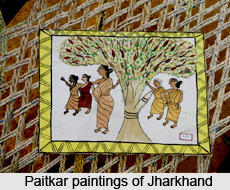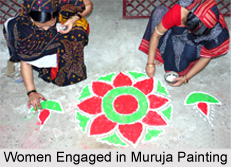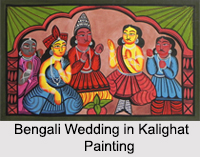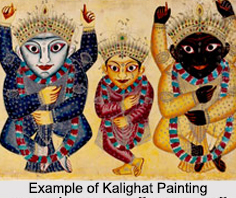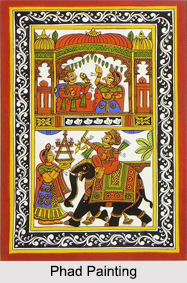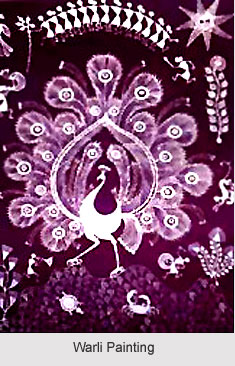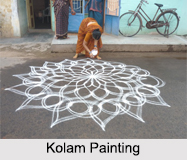 Kolam is a popular type of painting from Tamil Nadu, Karnataka, Andhra Pradesh, most of the parts of Kerala, some parts of Goa and Maharashtra region. Kolam is a geometrical line painting which is composed of curved loops, drawn around in a grid pattern of dots. In South India, it is widely practised by female Hindu family members in front of their houses. Kolams are regionally known by different names in India, "Rangoli" in Maharashtra, "Hase" and "Rangoli" in Karnataka, "Muggulu" in Andhra Pradesh, etc. In a South-Indian home, it is believed that Kolam painting presents wealth and success.
Kolam is a popular type of painting from Tamil Nadu, Karnataka, Andhra Pradesh, most of the parts of Kerala, some parts of Goa and Maharashtra region. Kolam is a geometrical line painting which is composed of curved loops, drawn around in a grid pattern of dots. In South India, it is widely practised by female Hindu family members in front of their houses. Kolams are regionally known by different names in India, "Rangoli" in Maharashtra, "Hase" and "Rangoli" in Karnataka, "Muggulu" in Andhra Pradesh, etc. In a South-Indian home, it is believed that Kolam painting presents wealth and success.
Traditional Significance of Kolam Painting
Apart from being used for decoration in a South-Indian house, Kolam painting also serves the other purposes. Earlier, Kolam paintings were drawn in coarse rice flour, so the ants and other small creatures would not have to walk too far or too long for a meal. Thus, Kolam paintings welcome the small creatures into one"s home; it is a regular tribute to the harmonious co-existence. It is also related to Lakshmi, the Goddess of prosperity and wealth. 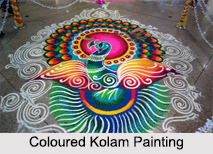
Legends have developed to consent that the lines must be finished in such a manner that a stop can be put towards the evil spirits from entering, and thus are they prevented from entering the inside of the home. It is used as a theme of pride to draw the large complex patterns without taking the hand from the floor or standing up in between.
Creation of Kolam Painting
Every morning before the sunrise, the place of the house where the Kolam will be drawn is cleaned with water and the muddy floor swept well to make an even surface. The Kolam paintings are usually drawn at the time when the surface is still damp so that the design can hold in a better way. Occasionally, cow dung is also used to polish the floors. The ritual Kolam patterns are created for special occasions such as weddings and so on. The white stone powder can be used for creating Kolam paintings.
Symbolism of Kolam Painting
Many designs of the Kolam paintings have been derived from some exquisite patterns and conceptual designs which have merged with the mixed philosophic and religious motifs. The patterns may comprise fish, birds and other animal images to represent the unity of people and other living things. A circle pattern symbolizes the nature while a square pattern represents the culture. A lotus pattern represents the womb. The sun, moon and other zodiac symbols are also used as a pattern for Kolam. The descending pointing triangle pattern represents woman; an upward pointing triangle pattern represents man in Kolam.
Different Patterns of Kolam Painting
A pattern in which a stroke runs once in the order of every dot and goes to the opening point, mostly geometrical figure, it is called as "Neli" pattern. There is another pattern in which a stroke runs in the order of each dot but remains as unlock. In another pattern, an outline in which strokes are connected between the dots and sometimes it symbolizes different kinds of objects, flowers, animals, etc. A pattern, in which dots are set in a radial planning, is called "Lotus" pattern. In another pattern, an outline is drawn in a free style and for the most part being colourized.
